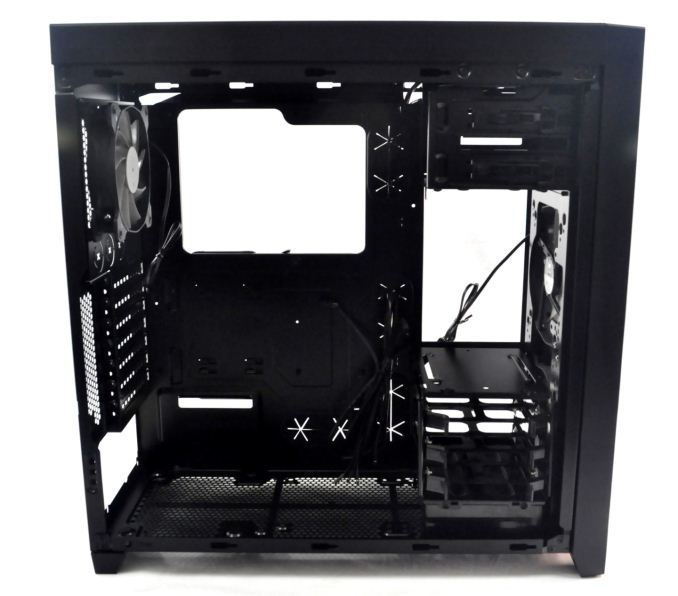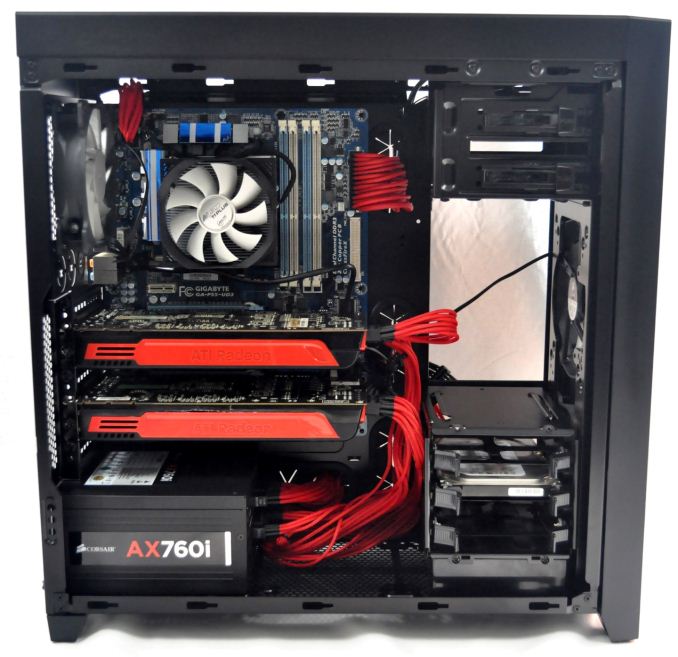Corsair Obsidian 450D Case Review
by E. Fylladitakis on April 4, 2014 6:00 AM EST- Posted in
- Cases/Cooling/PSUs
- Corsair
- mid-tower
- Case
Corsair Obsidian 450D Interior
The Obsidian 450D is entirely black and that includes every part of the interior, with the sole exception being the grey blades of the cooling fans. Mechanically, the Obsidian 450D is well designed for a case this size; most of the support depends on the motherboard tray, which is attached to the front panel via the 5.25" drive cage and a second support brace near the bottom of the case. A little flex is expected on the heavily perforated rear panel but there's nothing out of the ordinary.
The size of the motherboard tray is typical, designed to hold a full ATX motherboard. A huge opening assures the easy installation of most CPU coolers without the need to remove the motherboard from the case. Of course, smaller motherboards (Micro-ATX and Mini-ITX) can also be installed in the Obsidian 450D. Mini-ATX and narrow ATX motherboards will fit as well, but their right side will be far away from the cable hole openings and they will not cover the CPU cooler opening entirely. The clearance between the motherboard tray and the top panel is good, ensuring that liquid cooling radiators will fit; however, we strongly suggest sticking with <40mm thick radiator designs; otherwise the installation of the radiator can be obstructed by motherboard components.
It is possible to use a PSU of virtually any length with the Obsidian 450D. However, if you want to use the optional bottom intake, you need to stick with units that are 160mm long or shorter. In the case that you want to install a liquid cooling radiator there, we strongly suggest selecting a PSU that has the cable opening and/or modular connectors high up on the casing, as otherwise they might obstruct the installation of the radiator.
A single cage for up to three disk drives comes installed in the Obsidian 450D from the factory floor, with the option to add a second cage if necessary. The second cage is not included and has to be purchased separately. Each cage has three plastic trays, for the installation of an equal number of drives. Each tray can hold one 3.5" or 2.5" drive. 3.5" drives are secured by simply flexing the tray to make the metallic studs go into the screw holes of the drive, but screws are necessary for the installation of 2.5" drives. The cage itself is removable and can be installed near the bottom of the case, as pictured, or below the 5.25" drives cage. If you have plans on installing a radiator or fan at the bottom of the Obsidian 450D, the plastic frame that the drive cage sits on will have to be removed as well; this is done by removing four screws from the bottom of the case.
As is typical with all well-designed tower cases, there is ample clearance (21.3 mm from the tray to the side panel) behind the motherboard tray for the routing of cables. Corsair cleverly took advantage of that clearance and installed two additional 2.5" drive slots behind the motherboard tray. The slots are extremely easy to use; all it takes is to push a 2.5" HDD or SSD in the slot and it locks the drive into place.
Black cables and parts are easily hidden inside an all-black chassis; therefore, for visual clarity, we are using an AX760i PSU with a red cable pack and white SATA cables for our pictures. Building a system inside the Obsidian 450D is a nice experience, with most of the time required being for the routing of the cables. There are no sharp and or dangerous points about the Obsidian 450D that we could locate during our experience with it.
As exhibited in the pictures of our test build, the cables can be easily routed behind the motherboard tray and emerge from a grommet near their destination. For the CPU EPS 12V connector, Corsair positioned a small opening at the top left side of the motherboard tray. A graphics card of virtually any length can fit in the first PCI Express slot of the motherboard but it would be wise to stick with cards shorter than 260mm (10.1 in) for the other slots -- unless the drive cage is removed, in which case any card will fit. Most of the time required to build a system inside the Obsidian 450D will most likely be for the routing of the cables, which can make a bit of a mess behind the motherboard tray as there are very few cable tie mounting points. The 2.5" drive slots reduce the space available for the cables but they can be removed entirely if necessary.


















36 Comments
View All Comments
Communism - Friday, April 4, 2014 - link
Please use comparison tables/graphs of some sort (to compare them to the other cases you have reviewed), as these results are basically meaningless without them.Maybe do the tables/graphs comparing the temperature of each component at the longest time measurement the is common between each of the cases tested.
Communism - Friday, April 4, 2014 - link
Maybe start a "Case 2014" in "Bench"http://www.anandtech.com/bench/Cases/742
And put a link to it in each section of your results corresponding to the "Bench" entry you are talking about.
UltraWide - Friday, April 4, 2014 - link
This is actually a great idea!E.Fyll - Friday, April 4, 2014 - link
We just have too few samples right now. A database will be created once there are at least a few reviews of each type of case available.just4U - Friday, April 4, 2014 - link
Is that your new test PSU for builds, or is it just going to be used for Corsair stuff? It's a good power supply for getting a nice clean wiring job and makes things relatively easy for setup. btw, What extensions are those you are using? The red thingies.. is that a accessory from Corsair?poisonsnak - Saturday, April 5, 2014 - link
Corsair makes individually sleeved cables. I couldn't get them to come up on corsair.com for some reason but I found a blue kit on NCIX http://products.ncix.com/detail/corsair-profession...Black Obsidian - Friday, April 4, 2014 - link
It almost seems as though the 450D is the successor to the 650D. It basically trades the "old Corsair" design (fewer, larger fans, limited radiator support, full complement of drive cages) for the "new Corsair" design (lots of radiator support, and thus almost necessarily more, smaller fans, additional purchase to reach full complement of drive cages but 2.5" mounts behind the motherboard to compensate), shedding the fan controller in the process.And yet the point about the 650D costing nearly twice as much is a good one. Even as someone who owns and quite enjoys a 650D, I can't think of a good reason why that is. Sure, the extra drive cage and fan controller are handy, but not $100+ handy.
Also, E, although I know we don't (and are seemingly unlikely to ever) see eye-to-eye on the usefulness of your thermal testing method, I just wanted to say that I appreciate how you've been adapting your reviews to take into account other advice/requests, such depth measurements for the space behind the motherboard tray.
britjh22 - Friday, April 4, 2014 - link
I also appreciate the expanding of the articles based on feedback. Yesterday I left a comment on the Graphite 760T review (bottom of page 2 of comments), as I read it late, and I wonder if there would be any response? I think the discussion between E and Black Obsidian encapsulated many of the issues I have with the newer format, and I think there could be very interesting and informative articles to come out of it (investigation of how small component choices affect a testing situation, proving the new testing methodology is the way to go). Thanks for the articles E, keep it up, and thank you for considering the communities feedback!E.Fyll - Friday, April 4, 2014 - link
My apologies, I rarely keep track of the review comments after a day or two that the review has been published; otherwise I would not have the time to do any real work.I thoroughly explained that there is no "real world" testing that can be considered testing at all and stated the most important reasons. You cannot possibly correlate test results between different systems, not even if the system is an exact copy of your own. Even a different thermal paste on the CPU can alter the temperature by up to five degrees Celsius, let alone a different cooler and or component. Even worse, a single change of a BIOS setting from "quiet" to "performance" can drop a full-load temperature measurement by a dozen degrees. If a single setting is capable of changing the results that much when the system is exactly the same, that is proof enough that "real world" testing has nothing "real" about it and zero usefulness to the end reader. If you are making comparisons and correlations based on such tests, you are merely playing a guessing game; you can pretty much do that without any "real world test results" given to you, therefore such data have been useless to begin with and there was no point in doing any kind of testing.
When you want to test the thermal performance of anything, you add a constant and passive load to it, so as to have minimal variables to worry about and force the test subject to cope with the load by itself, unaided by external factors. Using an unknown, unstable and active load does not even qualify as testing by any kind of standard, it is just plain wrong. The very idea of doing "tests" that the reader will be expected to guess (!) the "correlation" of our results to what he/she expects from another system turns my stomach upside down. Instead of doing any kind of such useless testing, I would rather not do it at all and focus on the real factors that make cases sell; quality, functionality and aesthetics. (Come on, no one would buy a case that they do not like over one that they do like for a difference of even several degrees, let alone a couple at most)
I think that pretty much covers about everything.
britjh22 - Friday, April 4, 2014 - link
My main issue continues to be that this type (synthetic) of testing doesn't seem to be any more valuable for a buying/recommendation standpoint. It gives a very repeatable, scientific look at how a case can dissipate 850W of heat. However, how many readers are going to be buying this case to install a 850W heat generator, I'd guess not many.You alluded to the potentially significant difference one component being changed can make. If that is the case, what use are these tests to consumers. If buyers are looking at data comparatively (which I assume is the goal once enough cases have been run through these tests, readers are already requesting it), this data may lead to an incorrect judgement based on what is being installed.
I would love to see an article exploring different components effects on outcomes, and I understand your logic and reasoning regarding your testing methodology. However if the data is no more useful for making a buying decision, the better test isn't any more helpful from a reader's perspective. I would like to think there is a better conclusion then "there is no useful objective test because of system variability", but perhaps that is the answer.